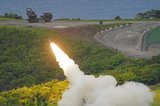Global Hawk completes first flight with MP-RTIP sensor
Northrop Grumman Corporation's RQ-4B Block 40 Global Hawk unmanned aircraft system (UAS) completed its first full system flight with the high performance AN/ZPY-2, also referred to as the Multi-Platform Radar Technology Insertion Program (MP-RTIP) sensor. The flight took place at Edwards Air Force Base, Calif., on July 21.
This is a first for a fleet of Block 40 Global Hawks that will be delivered to the UAS' main operating base at Grand Forks Air Force Base, N.D.
The MP-RTIP-equipped Block 40 Global Hawk provides unprecedented capabilities for both military and domestic applications. Flying at altitudes up to 60,000 feet for more than 32 hours per sortie at speeds approaching 340 knots, the Block 40 Global Hawk provides persistent coverage to see through all types of weather, day or night, thereby providing vital near real-time imagery to the warfighter.
"Since 2001 Global Hawk has provided critical resources to the warfighter, while accumulating more than 45,000 combat and humanitarian relief hours," said George Guerra, vice president, High Altitude Long Endurance Systems, Northrop Grumman Aerospace Systems. "The MP-RTIP equipped Global Hawk is the natural evolution of the program's advanced technology in providing invaluable intelligence, reconnaissance and surveillance capabilities for both military and domestic applications."
The Block 40 Global Hawk is a part of a growing Q-4 Enterprise family of unmanned systems developed by Northrop Grumman. The Q-4 Enterprise builds on the company's more than 60 years experience with unmanned aircraft and autonomous flight control, including more than 52,000 flight hours by the battle-proven RQ-4 Global Hawk.
Northrop Grumman Aerospace Systems is the prime contractor for the Global Hawk and MP-RTIP programs and continues to move these technologies forward under the stewardship of the Air Force's Aeronautical Systems Center at Wright-Patterson Air Force Base, Ohio, and Electronic Systems Center at Hanscom Air Force Base, Mass. Northrop Grumman Electronic Systems' Norwalk, Conn., facility is teamed with Raytheon Space and Airborne Systems, El Segundo, Calif., to develop, produce and deliver the AN/ZPY-2 MP-RTIP radar.
Source: Northrop Grumman
More from Uncrewed Vehicles
-
![What's next for the Pentagon after the Replicator programme?]()
What's next for the Pentagon after the Replicator programme?
Although the Replicator initiative has made several accomplishments, there are still multiple gaps to plug across the US Department of Defense (DoD) and its services.
-
![Cummings Aerospace showcases Hellhound loitering munition designed for US Army’s LASSO programme (video)]()
Cummings Aerospace showcases Hellhound loitering munition designed for US Army’s LASSO programme (video)
Cummings Aerospace presented its turbojet-powered Hellhound loitering munition at SOF Week 2025, offering a man-portable solution aligned with the US Army’s LASSO requirements.
-
![SOF Week 2025: PDW unveils attritable FPV drone for SOF operations at scale]()
SOF Week 2025: PDW unveils attritable FPV drone for SOF operations at scale
PDW has revealed its Attritable Multirotor First Person View drone at SOF Week 2025, offering special operations forces a low-cost, rapidly deployable platform for strike and ISR missions, inspired by battlefield lessons from Ukraine.
-
![SOF Week 2025: Teledyne FLIR white paper provides guidance on reusable loitering munitions]()
SOF Week 2025: Teledyne FLIR white paper provides guidance on reusable loitering munitions
Teledyne FLIR is highlighting the emerging requirements for 'recoverable and re-usable' loitering munitions across the contemporary operating environment during this week’s SOF Week conference in Tampa, Florida.
-
![SOF Week 2025: Kraken Technology group debuts K3 Scout USV in North America]()
SOF Week 2025: Kraken Technology group debuts K3 Scout USV in North America
High-performance maritime industry player Kraken Technology Group, based in the UK, has used the SOF Week conference in Tampa, Florida this week to debut its K3 Scout uncrewed surface vessel (USV) to the North American market.
-
![Palladyne AI and Red Cat to demonstrate capabilities for autonomous drone swarms to the US military]()
Palladyne AI and Red Cat to demonstrate capabilities for autonomous drone swarms to the US military
Red Cat and Palladyne AI recently conducted a cross-platform collaborative flight involving three diverse heterogeneous drones.

























